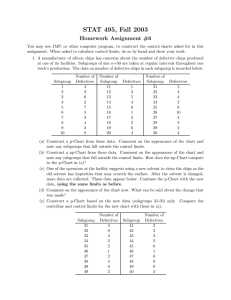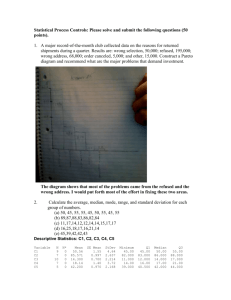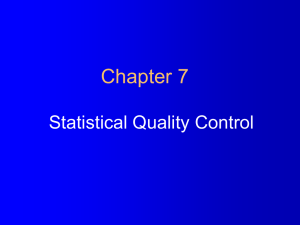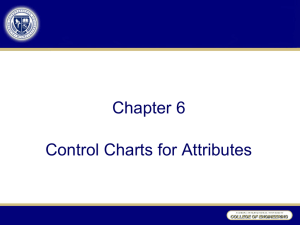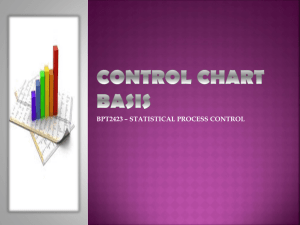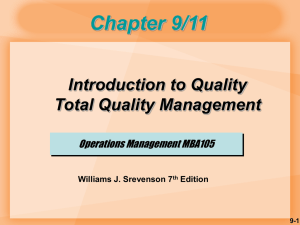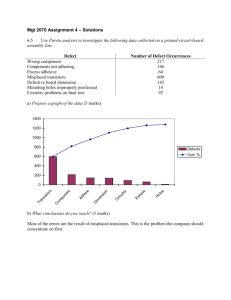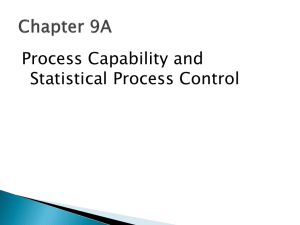Control Charts for Attributes - Welcome to brd4.braude.ac.il!
advertisement
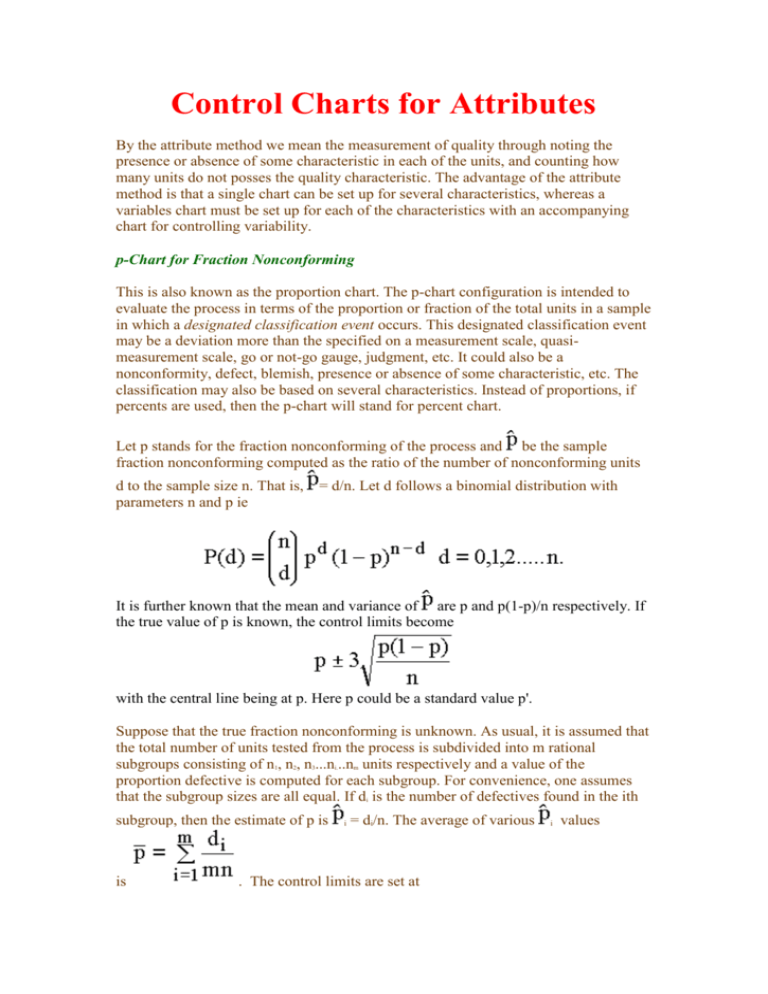
Control Charts for Attributes By the attribute method we mean the measurement of quality through noting the presence or absence of some characteristic in each of the units, and counting how many units do not posses the quality characteristic. The advantage of the attribute method is that a single chart can be set up for several characteristics, whereas a variables chart must be set up for each of the characteristics with an accompanying chart for controlling variability. p-Chart for Fraction Nonconforming This is also known as the proportion chart. The p-chart configuration is intended to evaluate the process in terms of the proportion or fraction of the total units in a sample in which a designated classification event occurs. This designated classification event may be a deviation more than the specified on a measurement scale, quasimeasurement scale, go or not-go gauge, judgment, etc. It could also be a nonconformity, defect, blemish, presence or absence of some characteristic, etc. The classification may also be based on several characteristics. Instead of proportions, if percents are used, then the p-chart will stand for percent chart. Let p stands for the fraction nonconforming of the process and be the sample fraction nonconforming computed as the ratio of the number of nonconforming units d to the sample size n. That is, parameters n and p ie = d/n. Let d follows a binomial distribution with It is further known that the mean and variance of are p and p(1-p)/n respectively. If the true value of p is known, the control limits become with the central line being at p. Here p could be a standard value p'. Suppose that the true fraction nonconforming is unknown. As usual, it is assumed that the total number of units tested from the process is subdivided into m rational subgroups consisting of n1, n2, n3...ni...nm units respectively and a value of the proportion defective is computed for each subgroup. For convenience, one assumes that the subgroup sizes are all equal. If di is the number of defectives found in the ith subgroup, then the estimate of p is is i = di/n. The average of various . The control limits are set at i values For example, consider the following data on the number of defectives obtained for 50 subgroups of 100 resistors drawn from a process. Table 3.12 Nonconforming resistors in various subgroups i di 1 2 3 4 5 6 7 8 9 10 0 0 2 0 1 0 2 2 1 1 i 0.00 0.00 0.02 0.00 0.01 0.00 0.02 0.02 0.01 0.01 i di 11 12 13 14 15 16 17 18 19 20 0 2 1 1 1 0 0 0 2 3 i 0.00 0.02 0.01 0.01 0.01 0.00 0.00 0.00 0.02 0.03 The table given below also gives the limits are found as i di 21 22 23 24 25 26 27 28 29 30 1 2 0 1 1 0 0 1 0 0 i i 0.01 0.02 0.00 0.01 0.01 0.00 0.00 0.01 0.00 0.00 i di 31 32 33 34 35 36 37 38 39 40 1 3 0 1 2 2 0 2 2 1 i 0.01 0.03 0.00 0.01 0.02 0.02 0.00 0.02 0.02 0.01 values. The value of i di 41 42 43 44 45 46 47 48 49 50 1 1 3 2 1 1 0 0 0 2 i 0.01 0.01 0.03 0.02 0.01 0.01 0.00 0.00 0.00 0.02 is 0.01. The control . Figure 3.44 provides the MINITAB p-chart output for the above data. Figure 3.44 MINITAB p-chart Output If the computed value for LCL is negative, it is set at zero. This means that there is no 'control' exercised to detect any quality improvement. If the subgroup sizes are unequal, then p is estimated as and the (varying) control limits are given by Alternatively, an 'average' sample size could be used. One can also plot the standardised value of pi against the control limits ±3. Choice of Subgroup Size Let p1 be the process average fraction defective (considered as acceptable) and suppose that we wish to detect a k level shift in a p-chart. That is, the process fraction defective shifts to an unacceptable level p2 = p1 + k. Let us further suppose that we wish to fix the probability of detecting the shift at 0.5. Under the normal approximation to binomial, the upper control limit of the p-chart based on p = p1 will coincide with p2. Hence one has From this relation, one obtains a formula for n as: For example, if the shift of the process to an unacceptable level of 0.02 from the acceptable level of 0.005 must be detected with 50% probability, the subgroup size should be about 200. If small subgroup sizes are used and p is small, the observance of one defective may mean an out-of-control signal. In order to avoid this, it may be desirable to have a large sample size for the p-chart. Sometimes it may be desirable to have a lower control limit greater than zero in order to look for samples that contain no defectives or to detect quality improvement. That is, it is desired that If p is small, obviously, the value of n should be very large. For example, for p = 0.01, the minimum subgroup size becomes 891. Operating Characteristic Curve 1. With only an upper control limit: The OC function giving the probability that a value of p=pi (or di) falls below the UCL [or int(nUCL)] is given by where n is the subgroup size. 2. With both lower and upper control limits: The OC function giving the probability that pi (or di) falls within the LCL and UCL is given by For very large subgroup sizes, LCL is also used as an action limit since a very low number of defectives may imply the inaccurate use of gages etc. The LCL is necessary to detect a quality improvement. If only quality degradation need be detected, the OC function based on the upper control limit should suffice. MINITAB macros can be used to draw the OC curves of a p-chart. For example, the OC curves of the p-chart having n=50, LCL=1 and UCL=18 are given in Figures 3.45 and 3.46. Figure 3.45 OC Curve With Both UCL and LCL Figure 3.46 OC Curve With Only UCL np-chart The np-chart is intended to evaluate the process in terms of the total number of units in a sample in which a given classification event occurs. The np-chart is essentially a p-chart, the only difference being the observed number of defectives is directly plotted instead of the observed proportion defective. If p is the proportion defective, then d, the number of defectives in the subgroup size n, follows a binomial distribution whose expected value is np with standard deviation . Here p could be a standard value. When no standards are available, one uses the estimate and draws the control limits at . The central line is drawn at n . The OC function of the np chart is similar to that of the p-chart and on the x-axis one plots the d values instead of p values. c-chart for Counts By the term area of opportunity, we mean a unit or a portion of material, process, product or service in which one or more designated events occur. The term is synonymous with the term unit and is usually preferred where there is no natural unit, eg continuous length of cloth. By defect, we mean the departure of a characteristic from its prescribed specification level that will render the product or service unfit to meet the normal usage requirements. By nonconformity, we mean a product which may not meet the specification requirement but may meet the usage requirements. For example, dirt in a block of cheese is a defect but underweight is a nonconformity. By c or count, we mean the number of events of a given classification occurring in a sample. More than one such event may occur in a desired area of opportunity. The c-chart or count chart is a configuration designed to evaluate the process in terms of the count of events (eg. defect or nonconformity) of a given classification occurring in a sample. We assume that the number of nonconformities d follows a Poisson distribution whose mean and variance are equal to the parameter c. That is, d follows: . The control chart for count d with three sigma limits is therefore c 3c, the central line being c. If LCL is less than zero, it is set at zero. Here c could be a standard value. In its absence, c is estimated as the average number of nonconformities in a sample, say , and the control limits are set at 3 . Consider the following table showing the number of nonconformities observed in a sample of 20 subgroups of cellular phones of five each. Here C1 stands for subgroup number and C2 stands for the number of events (defects) that occured in the given area of opportunity (phone). Table 3.13 Number of Nonconformities in various subgroups Row 1 2 3 4 5 6 7 8 9 10 11 12 13 14 15 16 17 18 19 20 The value of C1 C2 Row 1 3 21 1 0 22 1 1 23 1 1 24 1 0 25 2 1 26 2 0 27 2 0 28 2 1 29 2 0 30 3 0 31 3 2 32 3 0 33 3 1 34 3 2 35 4 2 36 4 0 37 4 0 38 4 0 39 4 2 40 C1 C2 Row 5 0 41 5 1 42 5 2 43 5 2 44 5 1 45 6 0 46 6 0 47 6 2 48 6 1 49 6 2 50 7 0 51 7 0 52 7 0 53 7 0 54 7 0 55 8 1 56 8 0 57 8 1 58 8 0 59 8 0 60 C1 C2 Row 9 1 61 9 1 62 9 1 63 9 2 64 9 2 65 10 0 66 10 1 67 10 0 68 10 1 69 10 0 70 11 3 71 11 0 72 11 2 73 11 0 74 11 1 75 12 1 76 12 0 77 12 0 78 12 0 79 12 0 80 C1 C2 Row 13 1 81 13 2 82 13 1 83 13 2 84 13 1 85 14 0 86 14 0 87 14 2 88 14 1 89 14 0 90 15 1 91 15 2 92 15 1 93 15 1 94 15 1 95 16 0 96 16 1 97 16 0 98 16 0 99 16 1 100 C1 17 17 17 17 17 18 18 18 18 18 19 19 19 19 19 20 20 20 20 20 C2 1 1 2 0 2 2 0 1 2 2 0 0 2 0 4 1 0 0 1 0 is 84/20 = 4.2. The control limits are then found as 4.2 3 or 0 to 10.4 and the central line is set at 4.2. One plots the total number of defects found in each subgroup thereafter in the c-chart. While using a c-chart, a signal for a special cause may require further analysis using a cause and effect diagram. Figure 3.48 is the MINITAB output of the c-chart for the above data. It should be noted that MINITAB has no provision to input subgroup codes for drawing a c-chart. Figure 3.48 MINITAB c-chart Output OC Function 1. With UCL only: If action is taken only with the upper control limit (ie d exceeding UCL), the OC function giving the probability of d being less than UCL is since d follows the Poisson distribution with parameter c. To obtain the OC curve, one computes Pa as above for a given value of c, and a plot of (c, Pa) will yield the OC curve. It can be noted that the above OC function is similar to the OC function of a single sampling plan (discussed in Chapter 4) with acceptance number Ac = int(UCL). The sample size of the single sampling plan cannot be interpreted directly. 2. With both LCL and UCL: The OC function of the c-chart with both LCL and UCL giving the probability of d falling within LCL and UCL is . It is easy to evaluate the OC function of the c-chart as While using calculators to find Pa, the recurrence relation or normal approximation may be useful. Figures 3.49 and 3.50 show the OC curves of a c-chart obtained using MINITAB macros. Figure 3.49 OC Curve With Only UCL Figure 3.50 OC Curve With Both UCL and LCL u-chart The u-chart or count per unit chart is a configuration to evaluate the process in terms of average number of events of a given classification per unit area of opportunity. The u-chart is convenient for a product composed of units whose inspection covers more than one characteristic such as dimension checked by gages, electrical and mechanical characteristics checked by tests, and visual defects observed by eye. Under these conditions, independent defects may occur in one unit of product and a preferred quality measure is to count all defects observed and divide by the number of units inspected to give a value for defects per unit, rather than a value for the fraction defective. Here only the independent defects are to be counted. The u-chart is particularly useful for products such as textiles, wire, sheet materials, etc, which are continuous and extensive. Here the opportunity for defects/nonconformities is large even though the chance of a defect at one spot is small. The total number of units tested is subdivided into m rational subgroups of size n each. For each subgroup, a value of u, the defects per unit, is computed. The average number of defects is found as Assuming that the number of defects follows the Poisson distribution, the control limits of the u-chart are given by, For unequal subgroups, is found as where ni is the ith subgroup size and ui is the number of defects per unit in the ith subgroup. Here n1 , n2 ... need not be whole numbers, eg the length of the cloth inspected may be 2.4 m. The control limits are set at One can also use the standardised variable and plot as an I-chart. If a c-chart is drawn with unequal subgroup sizes, the control limits are set at For the cellular phone data considered earlier, the u-chart drawn using MINITAB is given in Figure 3.51 (MINITAB requires the di values to be input directly rather than the ui values). Figure 3.51 MINITAB u-chart Output The OC function of the u-chart is similar to the OC function of the c-chart. One uses the relation c = nu and the results will follow. Demerit Charts and Defect Classification The c- and u-charts give equal importance to various types of defects irrespective of their degree of seriousness. Defects are usually classified into the following four types and charts (c or u) are separately drawn for each type of defect. Class I - Very Serious - leading directly to severe injury or catastrophic economic loss. Class II - Serious - leading to significant injury or significant economic loss. Class III - Major - leading to major problems in the normal usage. Class IV- Minor - leading to minor problems in the normal usage. Eg in textile garments, easy inflammability is a Class I defect: shrinkage or colour fade is a Class II defect, weaker weft yarn is Class III, and dirt is Class IV. By demerit, we mean a weighting given to a defect type to obtain a weighted quality score. Let there be k defect types. Also let dj be the number of defects due to the jth type and wj is the demerit score for the jth defect type. Then the statistic can be computed for each subgroup. Then will form the central line where is the mean of the D's computed for various subgroups and is the mean number of defects due to the jth type. The control limits become . In some applications, the demerit score will be distinguished from a quality score. By a quality score, we mean a numerical indicator to measure the relative quality of the incoming material, operations, in-process or final product or service etc. This score is often useful for the relative evaluation of quality. For example, if a large company is manufacturing a number of products for both local and export markets in different plants, a relative quality evaluation will be done with the quality scores. If qj is the quality score for each defect-product type (say), the control limits will be set at with the central line being drawn at management, this chart will be useful. For quality evaluation by top
